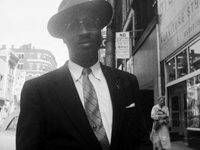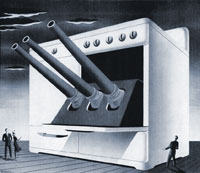Puck Building
In this podcast from the Bowery Boys, Greg Young narrates the history of New York's Puck Building, built to house the offices of the turn-of-the-century periodical Puck Magazine.
In this podcast from the Bowery Boys, Greg Young narrates the history of New York's Puck Building, built to house the offices of the turn-of-the-century periodical Puck Magazine.
From the BackStory website:
"Historian Cindy Aron discusses the origins of the modern American vacation. She explains why traveling to the beach didn't used to be appealing, and why Americans have often preferred 'self improvement' vacations to lazing around in a hammock."
From the BackStory website:
"Historian James Morone explains what nativism, racism, and women's suffrage had to do with the temperance movement of the early 20th century. And he argues that Prohibition was not the abysmal failure it's often made out to be.'"

Transcriptions and images of more than 4,000 newspaper advertisements for runaway slaves and indentured servants between 1736 and 1803 can be browsed or search on this website. The runaways are primarily from Virginia, but also come from states along the Eastern seaboard and locations abroad. Materials include ads placed by owners and overseers as well as those placed by sheriffs and other governmental officials for captured or suspected runaway slaves. Additional advertisements announce runaway servants, sailors, and military deserters.
"Exploring Advertisements" offers browse, search, and full-text search functions, as well as maps and timelines for viewing the geographic locations of slaves. The site also provides documents on runaways—including letters, other newspaper materials, literature and narratives, and several dozen official records, such as laws, county records, and House of Burgess journals. Information on the currency and clothing of the time, a gazetteer with seven maps of the region, and a 13-title bibliography are also available.
The 1857 Gallier House was designed by architect James Gallier, Jr. (born 1829) as his personal residence. The interior has been furnished to the period style immediately following the Civil War through 1880, and reflects the taste and lifestyle of wealthy urban designers of the day. The site also includes gardens, a carriage house, and restored slave quarters.
The house offers period rooms, one-hour guided tours, guided group tours, demonstrations for students, educational programs for students, history and archaeology summer camps, teacher workshops, and Scout workshops. Group tours are available by reservation on days when the museum is otherwise closed to the public. The website offers a virtual tour and lesson plans.
In 1864, Ben Holladay was awarded a contract to deliver mail from Salt Lake City to Walla Walla, WA. Rock Creek became a "home station," where stage drivers and attendants lived while they were off-duty and where passengers could buy a meal or a night's lodging. The original station consisted of a lava-rock building that served as a hotel and barn. In 1865 a store was built at the site. A small community grew up around the business, which also became a social center.
The site offers tours.
The Museum presents visitors with exhibits brimming with art and artifacts; contemporary, interactive areas for children and adults; an historic shipyard with five of the original 19th-century buildings; a Victorian-era shipyard owner's home; an active waterfront; and a life-size sculptural representation of the largest wooden sailing vessel ever built.
The museum offers exhibits, tours, boat cruises, classes, educational programs, research library access, and educational and recreational events.
The Museum is a recreation of the first McDonald's Restaurant opened in Des Plaines, IL, by McDonald's Corporation founder, Ray Kroc, on April 15, 1955. The customer service and food preparation areas contain original equipment used in the days when fresh potatoes were peeled, sliced, blanched and fried; milkshake mix and syrup were whipped up on the Multi-mixers; Coca-Cola and root beer were drawn from a barrel, and orangeade from the orange bowl. The all-male crew is represented by mannequins dressed in the 1955 uniform—dark trousers, white shirts, aprons, and paper hats. The basement features a historical display of photos, memos, early advertising, memorabilia, and a short video presentation.
The museum offers exhibits and a short film.

This archive of 1,500 photographs taken by Teenie Harris, photographer for the Pittsburgh Courier, "one of the largest and most influential Black newspapers in the country," documents African American urban life in Pittsburgh from the 1930s to the 1960s. This is a sample of the 80,000 images that make up the full collection. Many of the images have not been identified and the site's authors ask assistance (a submission form accompanies each image).
Visitors can browse the collection through 15 galleries of 100 images each. They can also comment on images and view the comments of others. Following the link to the Teenie Harris image collection in the Historic Pittsburgh Images Collections at the University of Pittsburgh allows visitors to browse the 541 images that have been identified with full captions. The site also offers a chronology of Harris's life. This site is useful for researching the history of Pittsburgh and its African American community as well as urban history or African American history in general.

I am looking for an electronic copy of a cartoon which shows most of the different aspects of the home front effort in America during World War II.
America’s home front effort included recruiting for the military, participating in scrap drives, paying income taxes, buying war bonds, using rationing coupons, planting Victory gardens, encouraging sanitation, volunteering for civil defense work, increasing public morale, and participating in industrial retooling and production. The Hollywood studios that were making cartoons at the beginning of the war were quickly drafted into turning their art to the war effort, to mobilize the American public. Cartoons were just one part of a propaganda effort, which also included the production and distribution of feature films, posters, war-themed commercial radio, newspaper and magazine advertising, the organization of celebrity tours and war bond drives, the establishment of censorship offices, and the formulation and distribution of a barrage of information and directives from various government officials and agencies.
Leon Schlesinger Productions produced popular cartoons featuring Daffy Duck and Bugs Bunny for Warner Brothers Studios, many of which had war themes, such as “The Ducktators” (1942), “Confusions of a Nutzy Spy” (1943), “The Fifth Column Mouse” (1943), “Tokio Jokio” (1943), “Daffy—The Commando” (1943), “Falling Hare” (1943), and “Draftee Daffy” (1945).
At least two of these Warner Brothers’ cartoons focused on home front activities and might be the cartoon you’re thinking of: “Scrap Happy Daffy” (1943), and ”Wacky Blackout” (1942).
Walt Disney also produced many war-themed cartoons with Mickey, Donald, Goofy and the rest of the gang, some of which were focused on the home front, such as “Out of the Frying Pan into The Firing Line” (1942), and ”Food Will Win the War” (1942).
A collection of short cartoons and movies from the Disney Studio during World War II, which includes many intended for the home front, was released (for purchase) in 2004 as a 2-disc DVD, “On the Front Lines,” in the series “Walt Disney Treasures.” This collection includes such titles as “Donald Gets Drafted” (1942), “Private Pluto” (1943), “Home Defense” (1943), “All Together” (1942), “Defense Against Invasion” (1943), and “Cleanliness Brings Health” (1945), as well as many others. The collection also includes Disney’s 1943 animated film, “Victory Through Air Power,” as well as a few of the hundreds of training films that the Disney studio made for the War Department or the National Film Board of Canada, such as “Four Methods of Flush Riveting” (1942).
Clayton R. Koppes and Gregory D. Black, Hollywood Goes to War: How Politics, Profits and Propaganda Shaped World War II Movies. Berkeley: University of California Press, 1990.
Thomas Doherty, Projections of War: Hollywood, American Culture, and World War II. New York: Columbia University Press, 1999.
James J. Kimble, Mobilizing the Home Front. College Station: Texas A&M University Press, 2006.
Steven Watts, The Magic Kingdom: Walt Disney and the American Way of Life. Boston: Houghton Mifflin, 1997.
Cass Warner-Sperling, Cork Millner, and Jack Warner. Hollywood Be Thy Name: The Warner Brothers Story. Lexington: University Press of Kentucky, 1999.